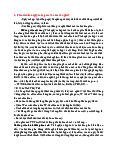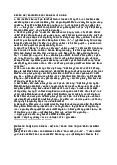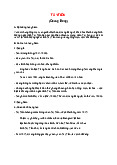

Preview text:
CHEMISTRY IN USE Research & Technology Ứng dụng của thuyết Lewis & VSEPR
Bài đọc thêm: The War against the Super Germs
Just a few years ago, medical practitioner thought that their rapidly expanding list of
antibiotics would eventually conquer most diseases-spreading microbes. That confidence
has disappeared with the emergence of some recent epidemics. Nearly every known disease
organism is now resistant to at least one antibiotic, and many diseases are immune to
several antibiotics. Scourges such as AIDS appear to defy all treatment. In addition, once-
conquered microorganisms such as tuberculosis bacteria are making a comeback as new
antibiotic-resistant strains called super germs.
Over the last few years, newspapers have carried many stories about super germs. For
example, in 1993, super germs struck a 1200-student high school in California. One third of
the pupils at this school tested positive for tuberculosis. At least a dozen of these students
were infected with strains of tuberculosis bacterium that do not respond to any of the antibiotics administered.
That same year, an epidemic of whooping cough (pertussis) struck children in Cincinnati.
Between 1979 and 1992, only 542 cases of whooping cough were reported in the United
States. In 1993 alone, there were 352 reported cases. Even more alarming is he realization
that an unusually hardly strain of the pertussis bacterium is emerging, one that is very
difficult to treat with standard antibiotics.
The cholera epidemic that killed 50,000 people in Rwandan refugee camps in 1994 involved
a strain of the cholera bacterium that cannot be treated with standard antibiotics.
One of medicine’s worst nightmares has recently come true in the form of drug-resistant
strain of severe invasive strep A, the so-called flesh-eating bacteria. Physicians worry that as
strep A infections increase, their treatment with antibiotics will further increase the drug- resistance of these microbes.
Bacteria become drug-resistant in a variety of ways, one of which is by producing special
chemicals called enzymes. Bacteria use enzyme molecules to render inactive the drug
molecules (antibiotics) that were once so effective in killing bacteria. The precise way in
which the molecular shapes of enzyme molecules match antibiotics molecules allows these
enzymes to trigger the deactivation of antibiotics molecules.
Chemists are trying to learn the molecular shapes of the enzyme molecules used by drug-
resistant bacteria. Then chemists may be able to design “fighter molecules” with the
molecular shapes needed to fit precisely onto these enzyme molecules and chemically
deactivate them. Once enzyme molecules are deactivated by fighter molecules, the bacteria
would be deprived of a crucial element of their defense. These bacteria would then become
susceptible again to the drugs that were lethal to them originally.
Knowing the structure of molecules is critically important to chemists because this
knowledge allows chemists to understand how molecules react. Models such as Lewis
structures and VSEPR theory are vitally important because they yield information about
molecular structure. Research chemists use even more sophisticated computer models to
study and develop drugs. Computer software allows chemists to see structures of molecules
on computer screens before the chemical are made. By using model to eliminate chemical
that are unlikely drug prospects, chemists can reduce the time required to develop disease- fighting drugs by many years.
If we didn’t have useful theories such as VSEPR and Lewis structures, we would have to
memorize the individual properties of many chemicals we know about. Using VSEPR theory
to predict molecular structures, you can mimic research chemists as you predict molecular
characteristics such as molecular shape, polarity, hydrogen bonding, and solubility.




